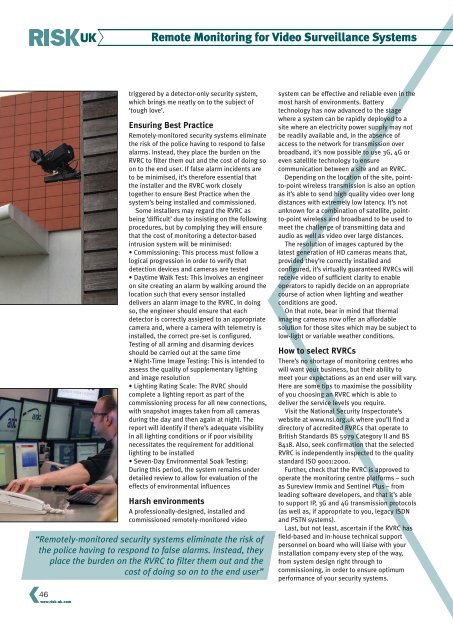RiskUKNovember2017
Create successful ePaper yourself
Turn your PDF publications into a flip-book with our unique Google optimized e-Paper software.
Remote Monitoring for Video Surveillance Systems<br />
triggered by a detector-only security system,<br />
which brings me neatly on to the subject of<br />
‘tough love’.<br />
Ensuring Best Practice<br />
Remotely-monitored security systems eliminate<br />
the risk of the police having to respond to false<br />
alarms. Instead, they place the burden on the<br />
RVRC to filter them out and the cost of doing so<br />
on to the end user. If false alarm incidents are<br />
to be minimised, it’s therefore essential that<br />
the installer and the RVRC work closely<br />
together to ensure Best Practice when the<br />
system’s being installed and commissioned.<br />
Some installers may regard the RVRC as<br />
being ‘difficult’ due to insisting on the following<br />
procedures, but by complying they will ensure<br />
that the cost of monitoring a detector-based<br />
intrusion system will be minimised:<br />
• Commissioning: This process must follow a<br />
logical progression in order to verify that<br />
detection devices and cameras are tested<br />
• Daytime Walk Test: This involves an engineer<br />
on site creating an alarm by walking around the<br />
location such that every sensor installed<br />
delivers an alarm image to the RVRC. In doing<br />
so, the engineer should ensure that each<br />
detector is correctly assigned to an appropriate<br />
camera and, where a camera with telemetry is<br />
installed, the correct pre-set is configured.<br />
Testing of all arming and disarming devices<br />
should be carried out at the same time<br />
• Night-Time Image Testing: This is intended to<br />
assess the quality of supplementary lighting<br />
and image resolution<br />
• Lighting Rating Scale: The RVRC should<br />
complete a lighting report as part of the<br />
commissioning process for all new connections,<br />
with snapshot images taken from all cameras<br />
during the day and then again at night. The<br />
report will identify if there’s adequate visibility<br />
in all lighting conditions or if poor visibility<br />
necessitates the requirement for additional<br />
lighting to be installed<br />
• Seven-Day Environmental Soak Testing:<br />
During this period, the system remains under<br />
detailed review to allow for evaluation of the<br />
effects of environmental influences<br />
Harsh environments<br />
A professionally-designed, installed and<br />
commissioned remotely-monitored video<br />
“Remotely-monitored security systems eliminate the risk of<br />
the police having to respond to false alarms. Instead, they<br />
place the burden on the RVRC to filter them out and the<br />
cost of doing so on to the end user”<br />
system can be effective and reliable even in the<br />
most harsh of environments. Battery<br />
technology has now advanced to the stage<br />
where a system can be rapidly deployed to a<br />
site where an electricity power supply may not<br />
be readily available and, in the absence of<br />
access to the network for transmission over<br />
broadband, it’s now possible to use 3G, 4G or<br />
even satellite technology to ensure<br />
communication between a site and an RVRC.<br />
Depending on the location of the site, pointto-point<br />
wireless transmission is also an option<br />
as it’s able to send high quality video over long<br />
distances with extremely low latency. It’s not<br />
unknown for a combination of satellite, pointto-point<br />
wireless and broadband to be used to<br />
meet the challenge of transmitting data and<br />
audio as well as video over large distances.<br />
The resolution of images captured by the<br />
latest generation of HD cameras means that,<br />
provided they’re correctly installed and<br />
configured, it’s virtually guaranteed RVRCs will<br />
receive video of sufficient clarity to enable<br />
operators to rapidly decide on an appropriate<br />
course of action when lighting and weather<br />
conditions are good.<br />
On that note, bear in mind that thermal<br />
imaging cameras now offer an affordable<br />
solution for those sites which may be subject to<br />
low-light or variable weather conditions.<br />
How to select RVRCs<br />
There’s no shortage of monitoring centres who<br />
will want your business, but their ability to<br />
meet your expectations as an end user will vary.<br />
Here are some tips to maximise the possibility<br />
of you choosing an RVRC which is able to<br />
deliver the service levels you require.<br />
Visit the National Security Inspectorate’s<br />
website at www.nsi.org.uk where you’ll find a<br />
directory of accredited RVRCs that operate to<br />
British Standards BS 5979 Category II and BS<br />
8418. Also, seek confirmation that the selected<br />
RVRC is independently inspected to the quality<br />
standard ISO 9001:2000.<br />
Further, check that the RVRC is approved to<br />
operate the monitoring centre platforms – such<br />
as Sureview Immix and Sentinel Plus – from<br />
leading software developers, and that it’s able<br />
to support IP, 3G and 4G transmission protocols<br />
(as well as, if appropriate to you, legacy ISDN<br />
and PSTN systems).<br />
Last, but not least, ascertain if the RVRC has<br />
field-based and in-house technical support<br />
personnel on board who will liaise with your<br />
installation company every step of the way,<br />
from system design right through to<br />
commissioning, in order to ensure optimum<br />
performance of your security systems.<br />
46<br />
www.risk-uk.com

















